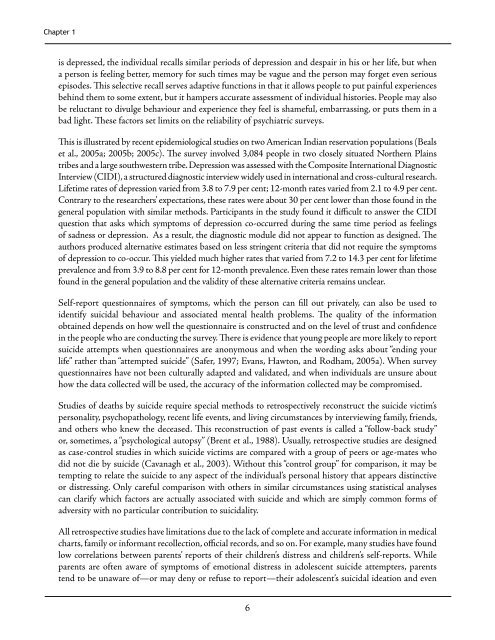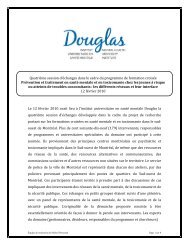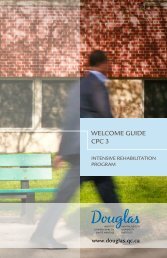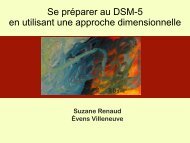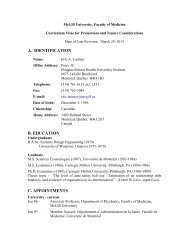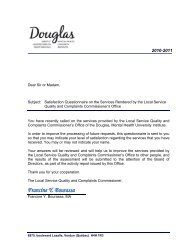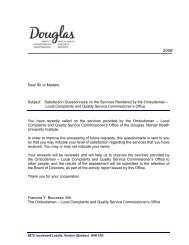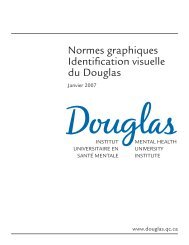Chapter 1Methods of Study<strong>in</strong>g <strong>Suicide</strong>There are three broad strategies for study<strong>in</strong>g the problem of suicide: cl<strong>in</strong>ical, epidemiological, andethnographic. Each has strengths and limitations. The <strong>in</strong>tegration of these forms of knowledge is an ongo<strong>in</strong>gchallenge <strong>in</strong> the field of mental health.Cl<strong>in</strong>ical ResearchCl<strong>in</strong>ical studies look at patients <strong>in</strong> health care sett<strong>in</strong>gs. Typically, such studies compare suicide attempterswith other patients seen <strong>in</strong> a cl<strong>in</strong>ic or a hospital. This allows systematic comparisons with patients whohave other types of mental health problems but who are not suicidal. For example, although depressionis strongly associated with suicide, only a m<strong>in</strong>ority of people with severe depression actually make suicideattempts. Understand<strong>in</strong>g the differences between those who do make suicide attempts and those who do notmay help to identify the crucial elements beyond depression and demoralization that contribute to suicidalbehaviour. Cl<strong>in</strong>ical studies may <strong>in</strong>clude the measurement of biological parameters as well as psychologicaland social dimensions of the <strong>in</strong>dividual’s experience. Ideally, cl<strong>in</strong>icians develop a good relationship withthe patients they work with to arrive at an accurate portrait of their personalities, life circumstances, andpredicament. However, the cl<strong>in</strong>ic rema<strong>in</strong>s a limited sett<strong>in</strong>g from which to understand <strong>in</strong>dividuals’ problems,which may be rooted <strong>in</strong> the contexts of family and community. As well, many people who make suicideattempts do not come for help or are seen <strong>in</strong> non-cl<strong>in</strong>ical sett<strong>in</strong>gs, and it can be mislead<strong>in</strong>g to generalize theexperiences of those <strong>in</strong> the community based on the subset of people who come to cl<strong>in</strong>ical attention.Cl<strong>in</strong>ical studies can describe the characteristics of suicide attempters who come or are brought for helpand can identify potentially important risk and protective factors. But cl<strong>in</strong>ical studies cannot determ<strong>in</strong>ethe prevalence <strong>in</strong> the community or the relative contributions to suicide risk <strong>in</strong> the general population.Information on the general population is important to identify social causes of suicidality and todevelop population-based methods of prevention. Community studies on mental health f<strong>in</strong>d that many<strong>in</strong>dividuals never come for help, preferr<strong>in</strong>g to deal with problems on their own or with the aid of familyand community resources. Those who do contact the health care system are seen ma<strong>in</strong>ly <strong>in</strong> primary care,not <strong>in</strong> psychiatry or mental health sett<strong>in</strong>gs. It is therefore necessary to conduct community surveys todeterm<strong>in</strong>e the true prevalence of suicide attempts and to study the effectiveness of family and communityresources, as well as professional <strong>in</strong>terventions (Goldberg and Huxley, 1992). Study<strong>in</strong>g the pathways tocare may also identify problems <strong>in</strong> recognition of distress and differences <strong>in</strong> treatment, and so improvethe delivery of appropriate care.Epidemiological ResearchEpidemiological surveys offer the best methods for identify<strong>in</strong>g risk and protective factors that function at thelevel of the vulnerable <strong>in</strong>dividual, as well as factors at the levels of family, social network, cultural community,society, or nation that may affect whole populations. Most epidemiological studies of suicide, however, havefocused on factors affect<strong>in</strong>g <strong>in</strong>dividuals rather than communities (Borges, Anthony, and Garrison, 1995).Current epidemiological research methods <strong>in</strong> psychiatry emphasize structured diagnostic <strong>in</strong>terviewsand systematic record<strong>in</strong>g of details of personal history and experience (Tsuang and Tohen, 2002).Unfortunately, <strong>in</strong>dividual memory is surpris<strong>in</strong>gly poor even for personally significant events, and recallis biased by present concerns and conceptions (Rogler, Malgady, and Tryon, 1992). Thus, when a person
Chapter 1is depressed, the <strong>in</strong>dividual recalls similar periods of depression and despair <strong>in</strong> his or her life, but whena person is feel<strong>in</strong>g better, memory for such times may be vague and the person may forget even seriousepisodes. This selective recall serves adaptive functions <strong>in</strong> that it allows people to put pa<strong>in</strong>ful experiencesbeh<strong>in</strong>d them to some extent, but it hampers accurate assessment of <strong>in</strong>dividual histories. <strong>People</strong> may alsobe reluctant to divulge behaviour and experience they feel is shameful, embarrass<strong>in</strong>g, or puts them <strong>in</strong> abad light. These factors set limits on the reliability of psychiatric surveys.This is illustrated by recent epidemiological studies on two American Indian reservation populations (Bealset al., 2005a; 2005b; 2005c). The survey <strong>in</strong>volved 3,084 people <strong>in</strong> two closely situated Northern Pla<strong>in</strong>stribes and a large southwestern tribe. Depression was assessed with the Composite International DiagnosticInterview (CIDI), a structured diagnostic <strong>in</strong>terview widely used <strong>in</strong> <strong>in</strong>ternational and cross-cultural research.Lifetime rates of depression varied from 3.8 to 7.9 per cent; 12-month rates varied from 2.1 to 4.9 per cent.Contrary to the researchers’ expectations, these rates were about 30 per cent lower than those found <strong>in</strong> thegeneral population with similar methods. Participants <strong>in</strong> the study found it difficult to answer the CIDIquestion that asks which symptoms of depression co-occurred dur<strong>in</strong>g the same time period as feel<strong>in</strong>gsof sadness or depression. As a result, the diagnostic module did not appear to function as designed. Theauthors produced alternative estimates based on less str<strong>in</strong>gent criteria that did not require the symptomsof depression to co-occur. This yielded much higher rates that varied from 7.2 to 14.3 per cent for lifetimeprevalence and from 3.9 to 8.8 per cent for 12-month prevalence. Even these rates rema<strong>in</strong> lower than thosefound <strong>in</strong> the general population and the validity of these alternative criteria rema<strong>in</strong>s unclear.Self-report questionnaires of symptoms, which the person can fill out privately, can also be used toidentify suicidal behaviour and associated mental health problems. The quality of the <strong>in</strong>formationobta<strong>in</strong>ed depends on how well the questionnaire is constructed and on the level of trust and confidence<strong>in</strong> the people who are conduct<strong>in</strong>g the survey. There is evidence that young people are more likely to reportsuicide attempts when questionnaires are anonymous and when the word<strong>in</strong>g asks about “end<strong>in</strong>g yourlife” rather than “attempted suicide” (Safer, 1997; Evans, Hawton, and Rodham, 2005a). When surveyquestionnaires have not been culturally adapted and validated, and when <strong>in</strong>dividuals are unsure abouthow the data collected will be used, the accuracy of the <strong>in</strong>formation collected may be compromised.Studies of deaths by suicide require special methods to retrospectively reconstruct the suicide victim’spersonality, psychopathology, recent life events, and liv<strong>in</strong>g circumstances by <strong>in</strong>terview<strong>in</strong>g family, friends,and others who knew the deceased. This reconstruction of past events is called a “follow-back study”or, sometimes, a “psychological autopsy” (Brent et al., 1988). Usually, retrospective studies are designedas case-control studies <strong>in</strong> which suicide victims are compared with a group of peers or age-mates whodid not die by suicide (Cavanagh et al., 2003). Without this “control group” for comparison, it may betempt<strong>in</strong>g to relate the suicide to any aspect of the <strong>in</strong>dividual’s personal history that appears dist<strong>in</strong>ctiveor distress<strong>in</strong>g. Only careful comparison with others <strong>in</strong> similar circumstances us<strong>in</strong>g statistical analysescan clarify which factors are actually associated with suicide and which are simply common forms ofadversity with no particular contribution to suicidality.All retrospective studies have limitations due to the lack of complete and accurate <strong>in</strong>formation <strong>in</strong> medicalcharts, family or <strong>in</strong>formant recollection, official records, and so on. For example, many studies have foundlow correlations between parents’ reports of their children’s distress and children’s self-reports. Whileparents are often aware of symptoms of emotional distress <strong>in</strong> adolescent suicide attempters, parentstend to be unaware of—or may deny or refuse to report—their adolescent’s suicidal ideation and even
- Page 1 and 2: Suicide Among Aboriginal Peoplein C
- Page 3 and 4: Aboriginal Healing Foundation75 Alb
- Page 6 and 7: Table of ContentsPreface...........
- Page 8 and 9: Table of ContentsCultural and Lingu
- Page 10: PrefaceThis report was prepared und
- Page 14 and 15: GlossaryAmbivalence - Ambivalence r
- Page 16 and 17: GlossaryParasuicide - Any acute, in
- Page 18 and 19: Chapter 1IntroductionWhen I was 14
- Page 20 and 21: Chapter 1Definitions of Suicide and
- Page 24 and 25: Chapter 1suicide attempts (Marttune
- Page 26 and 27: Chapter 1A central problem for cros
- Page 28 and 29: Chapter 2The Epidemiology of Suicid
- Page 30 and 31: Chapter 2the economic status of Abo
- Page 32 and 33: Chapter 2No study to date has syste
- Page 34 and 35: Chapter 2Despite the overall patter
- Page 36 and 37: Chapter 2Figure 2-6) Average Annual
- Page 38 and 39: Chapter 2are only a portion of thos
- Page 40 and 41: Chapter 2Figure 2-9) Suicide Rates
- Page 42 and 43: Chapter 2Indeed, the rising rate of
- Page 44 and 45: Chapter 2Figure 2-11) Number of Dea
- Page 46 and 47: Chapter 2Rate per 100,000 populatio
- Page 48 and 49: Chapter 2There are only a handful o
- Page 50 and 51: Chapter 3Origins of Suicide: Indivi
- Page 52 and 53: Chapter 3Anxiety disorders also car
- Page 54 and 55: Chapter 3Many of the factors associ
- Page 56 and 57: Chapter 3American Indians compared
- Page 58 and 59: Chapter 3genetic and constitutional
- Page 60 and 61: Chapter 3Single-parent families are
- Page 62 and 63: Chapter 3Hopelessness, Problem Solv
- Page 64 and 65: Chapter 3higher rates of suicidal b
- Page 66 and 67: Chapter 3Physical EnvironmentSuicid
- Page 68 and 69: Chapter 31990; Chandler, 1994). Thi
- Page 70 and 71: Chapter 3Risk FactorsDepressionSubs
- Page 72 and 73:
Chapter 4Origins of Suicide: Social
- Page 74 and 75:
Chapter 4Reserves, Settlements, and
- Page 76 and 77:
Chapter 4Traditionalism versus accu
- Page 78 and 79:
Chapter 4are equivalent in seriousn
- Page 80 and 81:
Chapter 4society (Levy and Kunitz,
- Page 82 and 83:
Chapter 4those of mother and homema
- Page 84 and 85:
Chapter 4Duncan Campbell Scott, Dep
- Page 86 and 87:
Chapter 4Traditional Aboriginal com
- Page 88 and 89:
Chapter 4Feehan, 1996; Grant, 1996;
- Page 90 and 91:
Chapter 4The Child Welfare System a
- Page 92 and 93:
Chapter 4Aboriginal communities and
- Page 94 and 95:
Chapter 4had extremely high rates.
- Page 96 and 97:
Chapter 4Figure 4-2) Transgeneratio
- Page 98 and 99:
Chapter 5What Works in Suicide Prev
- Page 100 and 101:
Chapter 5Table 5-1) Strategies of I
- Page 102 and 103:
Chapter 5Effective Suicide Preventi
- Page 104 and 105:
Chapter 5closet rods that give way
- Page 106 and 107:
Chapter 5The American Indian Life S
- Page 108 and 109:
Chapter 51) school-based and commun
- Page 110 and 111:
Chapter 5reduce suicides that follo
- Page 112 and 113:
Chapter 5Although they may visit a
- Page 114 and 115:
Chapter 6Conclusion: Understanding
- Page 116 and 117:
Chapter 6Figure 6-1) An Integrative
- Page 118 and 119:
Chapter 6in large urban settings th
- Page 120 and 121:
Chapter 6there’s like a program s
- Page 122 and 123:
Chapter 6Figure 6-2) Levels of Inte
- Page 124 and 125:
Chapter 6Planning and CoordinationA
- Page 126 and 127:
Chapter 62) The response to the cri
- Page 128:
Chapter 6Often, suicide is a respon
- Page 131 and 132:
Appendix AASIST participants receiv
- Page 133 and 134:
Appendix AThe Training for Youth Ed
- Page 135 and 136:
Appendix AThe program has continued
- Page 137 and 138:
Appendix Awith the creation and imp
- Page 139 and 140:
Appendix AContact Information for R
- Page 142 and 143:
Appendix BAdditional Resources: Man
- Page 144:
Appendix BAboriginal Healing and We
- Page 147 and 148:
Appendix CNational Aboriginal Healt
- Page 149 and 150:
References——— (1987). Unravel
- Page 151 and 152:
ReferencesBeck, A.T., R.A. Steer, M
- Page 153 and 154:
ReferencesBrent, D.A., J.A. Perper,
- Page 155 and 156:
References——— (1995). The Pro
- Page 157 and 158:
ReferencesDevereux, G. (1961). Moha
- Page 159 and 160:
References——— (2005b). In wha
- Page 161 and 162:
ReferencesGardiner, H. and B. Gaida
- Page 163 and 164:
ReferencesGuo, B. and C. Harstall (
- Page 165 and 166:
ReferencesHoberman, H.M. and B.D. G
- Page 167 and 168:
ReferencesJong, M. (2004). Managing
- Page 169 and 170:
ReferencesKouri, R. (2003). Persona
- Page 171 and 172:
References——— (1997). Suicide
- Page 173 and 174:
ReferencesMatheson, L. (1996). The
- Page 175 and 176:
ReferencesNeimeyer, R.A., B. Fortne
- Page 177 and 178:
ReferencesPirkis, J.E., C.E. Irwin,
- Page 179 and 180:
ReferencesRutz, W. (2001). Preventi
- Page 181 and 182:
References——— (1992). Marriag
- Page 183 and 184:
ReferencesTrimble, J. and B. Medici
- Page 185 and 186:
ReferencesWebb, J.P. and W. Willard


